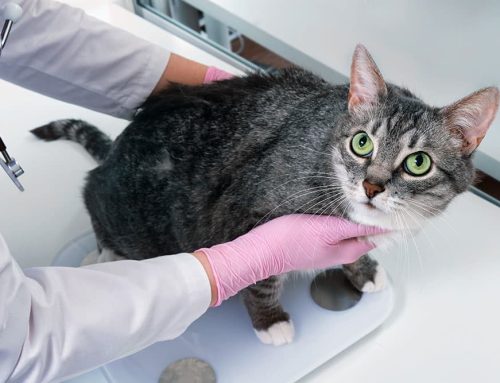Is your aging pet experiencing “senior moments?” They may be suffering from cognitive dysfunction syndrome (CDS), a common, but little-known, degenerative brain condition that closely resembles Alzheimer’s disease. Senior pets with CDS need extra support and understanding as they cope with the progressive changes.
What is happening to my pet?
CDS typically affects geriatric dogs and cats (i.e., pets older than 11 years of age). Prevalence increases with age, because neural tissue in the aging brain is less responsive to natural oxidative damage, the brain is unable to “clean house,” and harmful oxidative byproducts and abnormal B-amyloid protein deposits (i.e., plaques) accumulate in the brain matter and impair cognitive function. Combined with other natural, inescapable age-related changes (e.g., reduced brain mass, fewer nerve cells, tissue degeneration), CDS hastens brain deterioration—specifically memory, awareness, perception, and learning.
How can I tell if my pet has cognitive dysfunction syndrome?
Outward CDS signs include visible behavior and personality changes that steadily decline. Like Alzheimer’s in people, CDS can be scary and frustrating for pets and owners, and cause unhealthy stress, fear, and agitation. While this condition is incurable and progressive, early recognition can help ease your pet’s anxiety and protect them from injury.
Here are seven signs that your pet may be experiencing cognitive decline:
- Your pet seems lost in the house — Geriatric pets with CDS may appear to lose their way in familiar places, such as becoming “trapped” in a corner or behind furniture that they have negotiated for years. Other times, pets may wander aimlessly or in panic through the home, but when the owner comes to their aid, the pet may appear relieved, confused, or completely unbothered—as if nothing happened. As with several other CDS signs, disorientation may be attributed to or complicated by sensory decline (e.g., vision or hearing loss).
- Your pet doesn’t recognize familiar people — Similar to being lost in a familiar space, pets with CDS may no longer recognize friends, family, or their owner. Initial signs may be subtle (e.g., the pet hangs back as if sizing up the person, but eventually comes around) or alarming and uncharacteristic (e.g., pets may appear startled or bark, growl, or hiss).
- Your pet goes to the wrong side of a door — When going outside or exiting a room, pets with CDS may wait at the wrong (i.e., hinge) side of the door. This mistake is understandable in unfamiliar environments, but the confusion can occur at familiar thresholds that the pet has used their entire life.
- Your pet is active at night and asleep during the day — Pets suffering from CDS wake and sleep in altered cycles, similar to sundowners in elderly people. This behavior change is often the most disruptive and damaging CDS sign, because the pet’s and the owner’s healthy rest is impacted. Restless pets are also more likely to injure themselves at night, especially if they are visually impaired.
- Your pet paces or walks in circles — Pets may pace and circle at any time during their wake cycle, day or night. These repetitive behaviors may be accompanied by panting or heavy breathing that may indicate stress, anxiety, or pain, although knowing whether the movement provoked the stress and pain, or the pet is attempting to find relief from those issues, is impossible.
- Your pet is having urinary or fecal accidents — Although senior and geriatric pets commonly have incontinence and urinary issues, a sudden loss of house or litter box training in previously well-mannered pets can signal CDS. This is especially true when the accidents occur right after the pet visits the proper elimination spot (e.g., outside, in the litter box) or when they eliminate in front of the owner.
- Your pet changes personality — Cognitive decline can alter a pet’s personality. Confident pets may become insecure, fearful, or abnormally needy, while previously calm pets may become hyperactive and restless. Other changes can include self-isolation or detachment from the social group, disinterest in favorite activities, and no longer wanting to play or receive physical affection.
How can I help my pet cope with cognitive dysfunction?

In addition to sensory loss, many age-related medical conditions can cause dementia-like signs, so you need to schedule an appointment with Mobile Cat & Dog Vet if your pet’s behavior or personality have changed.
Watching your beloved pet navigate life with CDS can be emotionally challenging but, fortunately, various therapeutic options can reduce the stress and anxiety for you both. We will customize an individual treatment plan for your pet that may include:
- Medications — These may include selegiline for dogs, or anti-anxiety or antidepressant medications.
- Fatty acid and antioxidant supplementation — Supplements promote brain health, reduce inflammation, and fight oxidative damage.
- Lifestyle changes — Maintaining a routine can help pets feel calmer and more secure.
- Restricting access to hazards — Using pet gates, leashes, and other barriers prevent pets from falling down stairs or wandering out of the yard.
- Brain games — Mental stimulation can decrease stress and possibly delay disease progression. Ideas include taking a walk, playing with a new toy, learning a new trick, or the BrainBowl™—a puzzle toy designed to address cognitive decline in dogs.
Mobile Cat & Dog Vet delivers the highest level of in-home senior pet veterinary care and compassionate end-of-life services to your furry best friend. If you’re concerned about your aging pet’s physical or emotional health, or simply want to help them shine bright throughout their golden years, contact us to schedule a convenient in-home appointment.








Leave A Comment